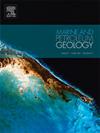大民屯凹陷低成熟沙四页岩运移沥青富集及孔隙网络发育的多学科特征
IF 3.6
2区 地球科学
Q1 GEOSCIENCES, MULTIDISCIPLINARY
引用次数: 0
摘要
渤海湾盆地古近系大民屯凹陷低熟页岩油资源广泛发育,但由于孔隙构型和储层空间分布不明确,制约了其高效开发。以低成熟度Es4页岩为研究对象,综合S352井岩心观测、地球化学测试、x射线衍射、扫描电镜(SEM)和压汞孔隙度测定(MIP)等数据,研究岩相控制的孔隙结构和剩余油特征。确定了3种岩相储层:层状长英质页岩(LFS)、混合页岩(MS)和块状白云质泥岩(MDM)。LFS和MS具有丰富的I型干酪根,生烃和留烃性能优异。LFS具有丰富的介孔、强的连通性和层理平行裂缝等特征,是原位生油和排轻油的有利甜点。MS为过渡性相,生成性和物性适中。相比之下,MDM由于TOC含量低,孔隙连通性差,缺乏生成能力,只能作为二级储层储存邻近LFS的运移油。热成熟度评估显示,高Tmax值(高达465°C)表明产油峰值,尽管测量到的Ro低(~ 0.6%),可能受到藻类干酪根的抑制。多尺度孔隙分析表明,LFS具有最大的累积孔隙体积和最发达的孔隙裂缝网络,而MDM具有孤立的、成岩蚀变的孔隙。地球化学分带和气相色谱指纹图谱将LFS/MS中的原生烃与MDM中的运移油区分出来,证实了地层限制的运移。层状页岩,特别是具有互层状MDM层段的层状页岩,具有最佳的甜点开发条件,因为短程运移可以丰富储层潜力,而无需高成熟度。该研究强调了低成熟度页岩油系统的可行性,并强调了整合岩相、地球化学和孔隙网络结构来预测最佳勘探点的重要性。本文章由计算机程序翻译,如有差异,请以英文原文为准。
Multidisciplinary characterization of migrated bitumen enrichment and pore network development in low-maturity Es4 shales of the Damintun Sag, East China
Low-maturity shale oil resources are widely developed in the Paleogene-aged Damintun Sag of the Bohai Bay Basin, yet the unclear pore architecture and reservoir space distribution have hindered its efficient exploitation. Focusing on the low-maturity Es4 shale, this study integrates core observations, geochemical tests, X-ray diffraction, scanning electron microscopy (SEM), and mercury intrusion porosimetry (MIP) data from Well S352 to investigate lithofacies-controlled pore structures and residual oil characteristics. Three lithofacies reservoirs are identified: laminated felsic shale (LFS), mixed shale (MS), and massive dolomitic mudstone (MDM). LFS and MS are rich in Type I kerogen excellent hydrocarbon generation and retention. LFS acts as both source and reservoir rock, featuring abundant mesopores, strong pore connectivity, and bedding-parallel fractures, making it a favorable sweet spot for in situ generation and light oil expulsion. MS serves as a transitional facies with moderate generative and physical properties. In contrast, MDM, with low TOC and poor pore connectivity, lacks generative capacity and instead functions as a secondary reservoir that stores migrated oil from adjacent LFS. Thermal maturity assessments show high Tmax values (up to 465 °C) indicative of peak oil generation, despite low measured Ro (∼0.6 %), likely suppressed by algal kerogen. Multiscale pore analyses reveal that LFS contains the highest cumulative pore volume and most developed pore–fracture networks, while MDM exhibits isolated, diagenetically altered pores. Geochemical zonation and gas chromatography fingerprinting distinguishes indigenous hydrocarbons in LFS/MS from migrated oils in MDM, confirming stratigraphically confined migration. Laminated shale—particularly those with interbedded MDM intervals—show optimal conditions for sweet spot development, as short-range migration enriches reservoir potential without requiring high maturity. This study underscores the viability of low-maturity shale oil systems and emphasizes the importance of integrating lithofacies, geochemistry, and pore network architecture to predict sweet spots for optimized exploration in lacustrine shale formations.
求助全文
通过发布文献求助,成功后即可免费获取论文全文。
去求助
来源期刊

Marine and Petroleum Geology
地学-地球科学综合
CiteScore
8.80
自引率
14.30%
发文量
475
审稿时长
63 days
期刊介绍:
Marine and Petroleum Geology is the pre-eminent international forum for the exchange of multidisciplinary concepts, interpretations and techniques for all concerned with marine and petroleum geology in industry, government and academia. Rapid bimonthly publication allows early communications of papers or short communications to the geoscience community.
Marine and Petroleum Geology is essential reading for geologists, geophysicists and explorationists in industry, government and academia working in the following areas: marine geology; basin analysis and evaluation; organic geochemistry; reserve/resource estimation; seismic stratigraphy; thermal models of basic evolution; sedimentary geology; continental margins; geophysical interpretation; structural geology/tectonics; formation evaluation techniques; well logging.
 求助内容:
求助内容: 应助结果提醒方式:
应助结果提醒方式:


